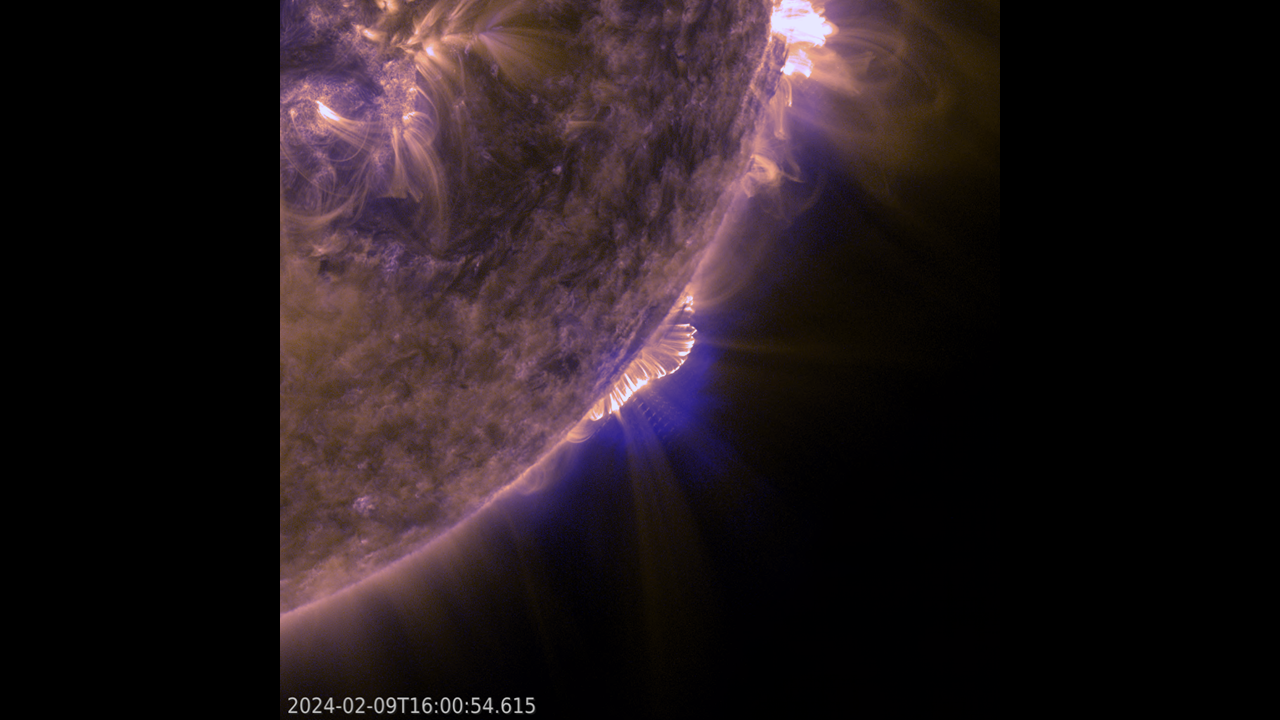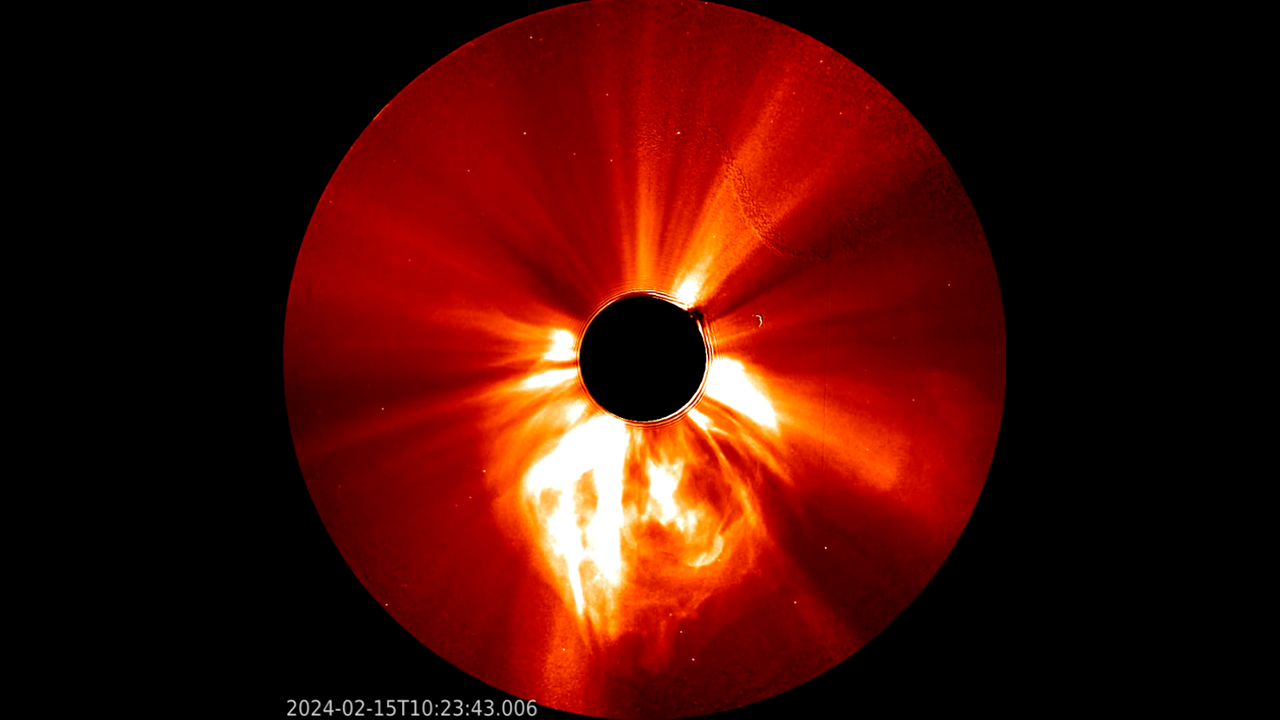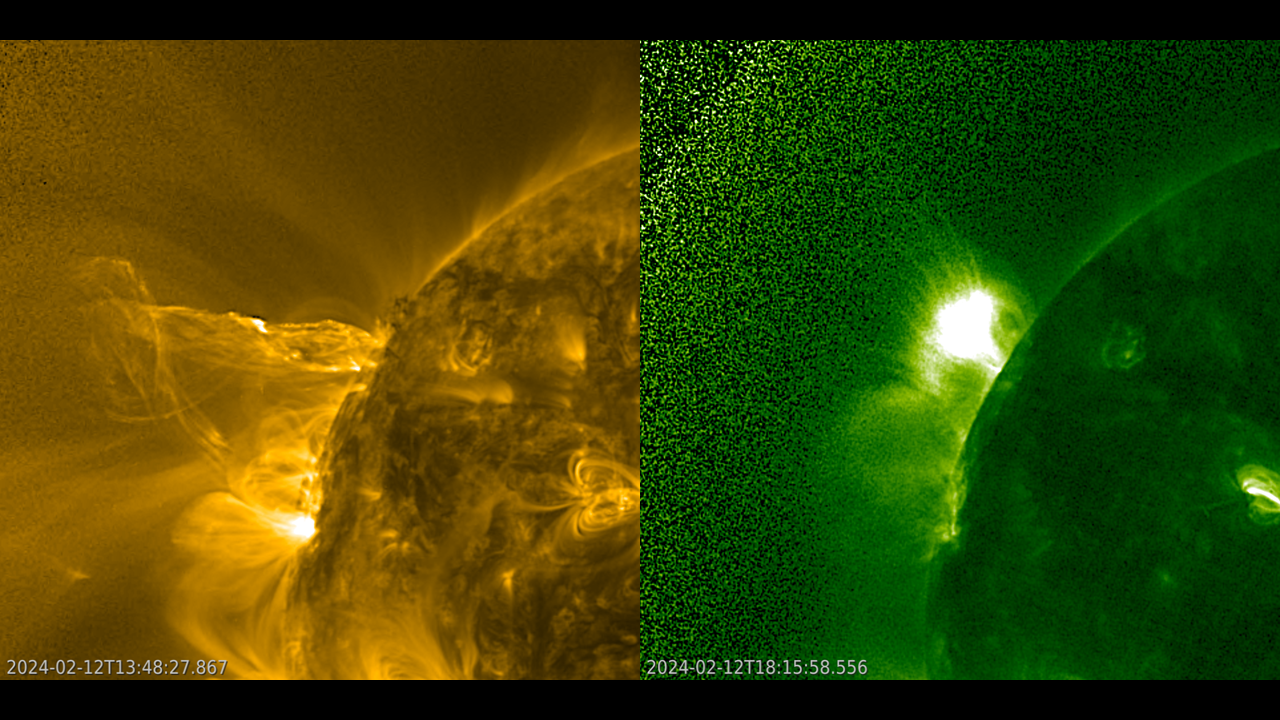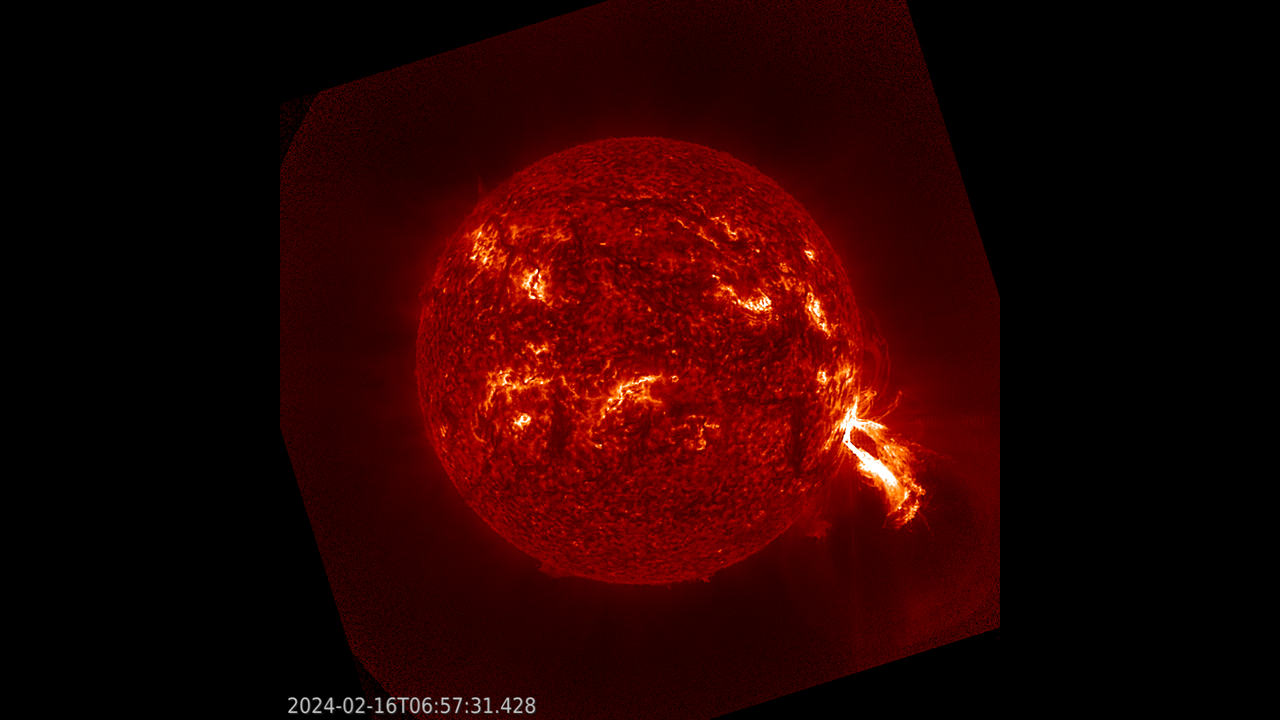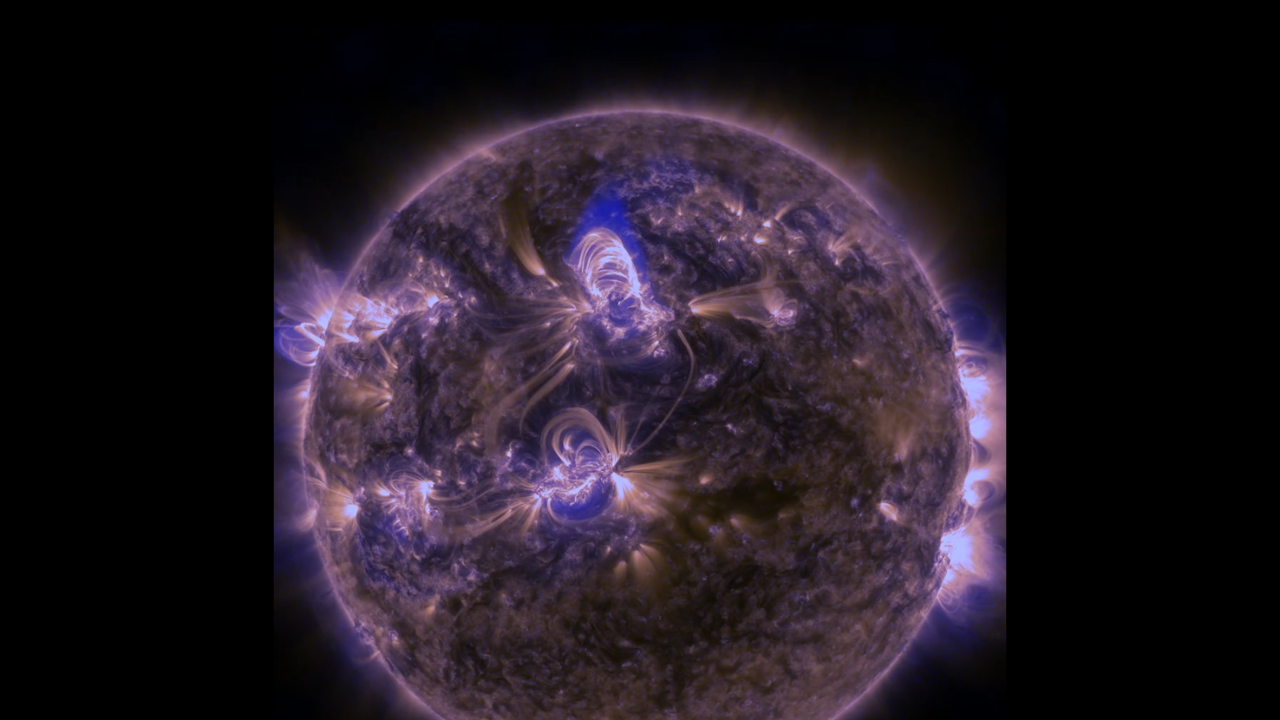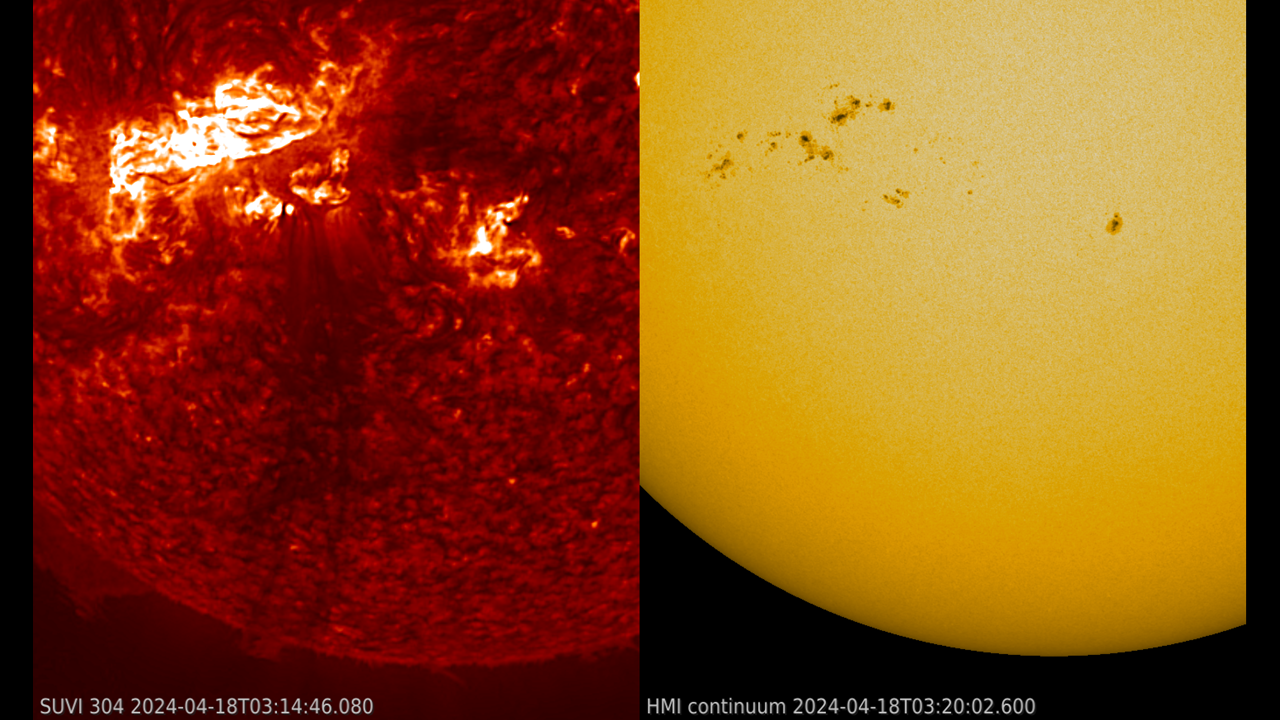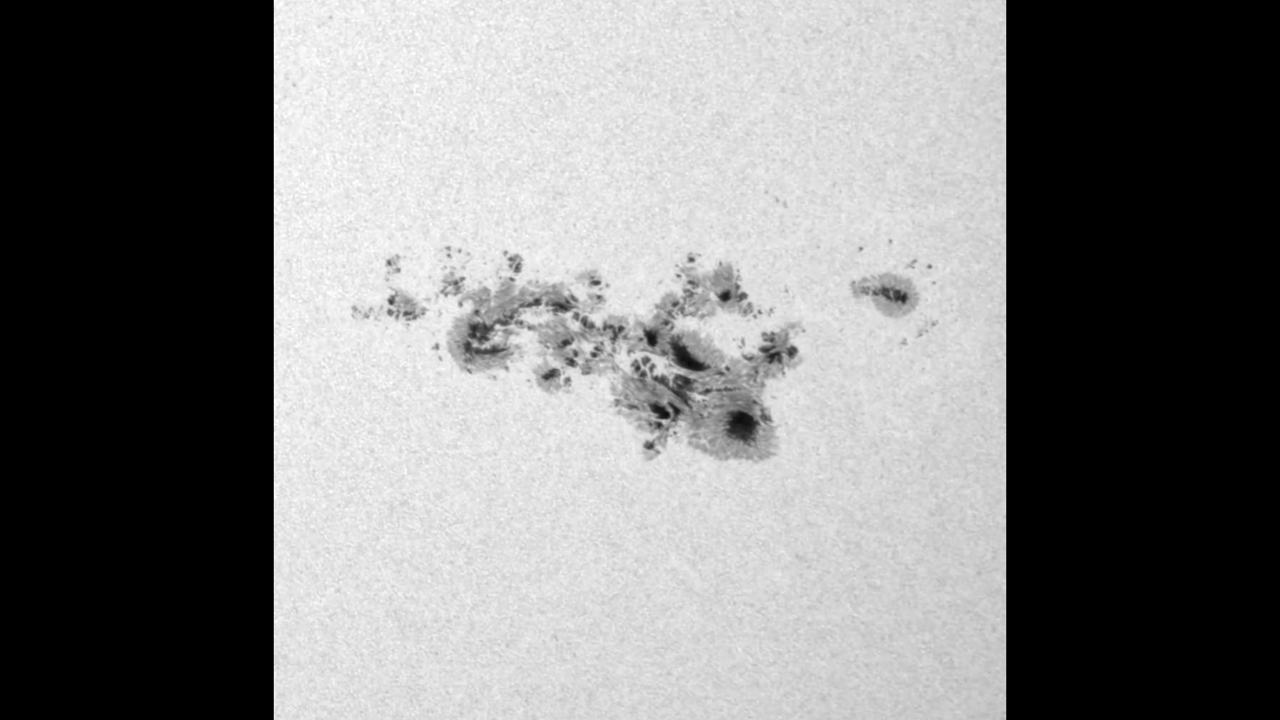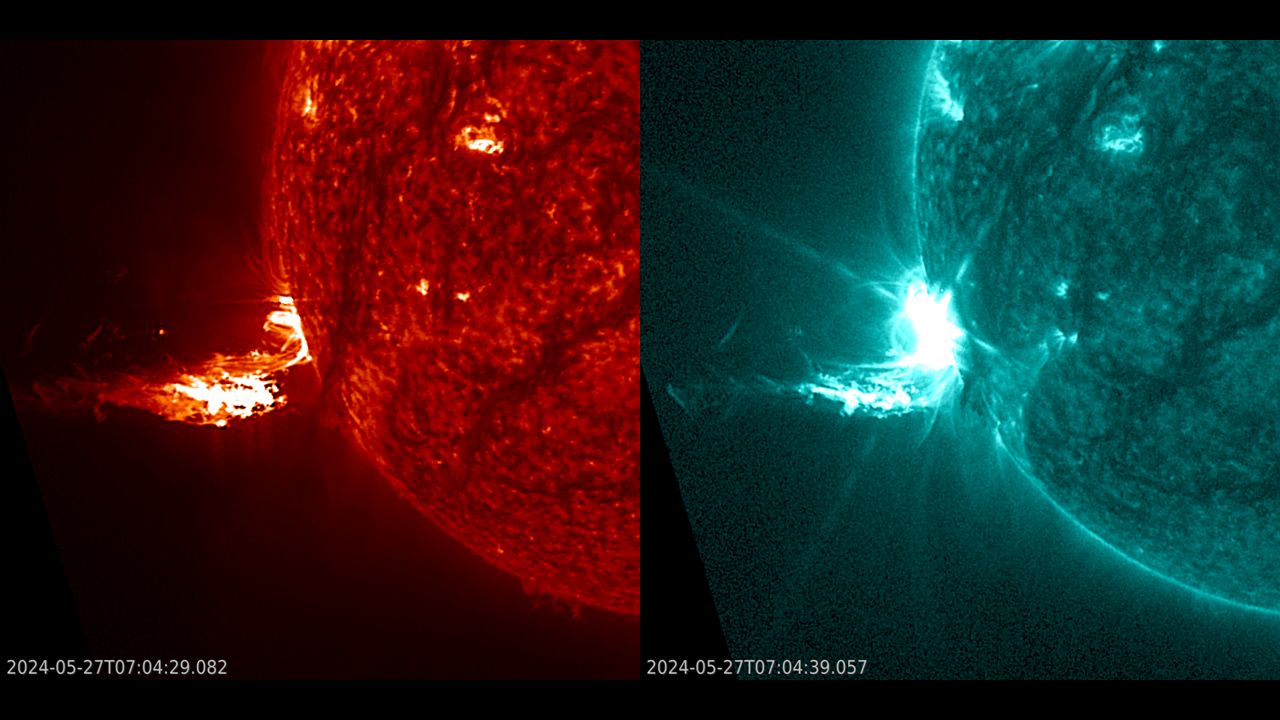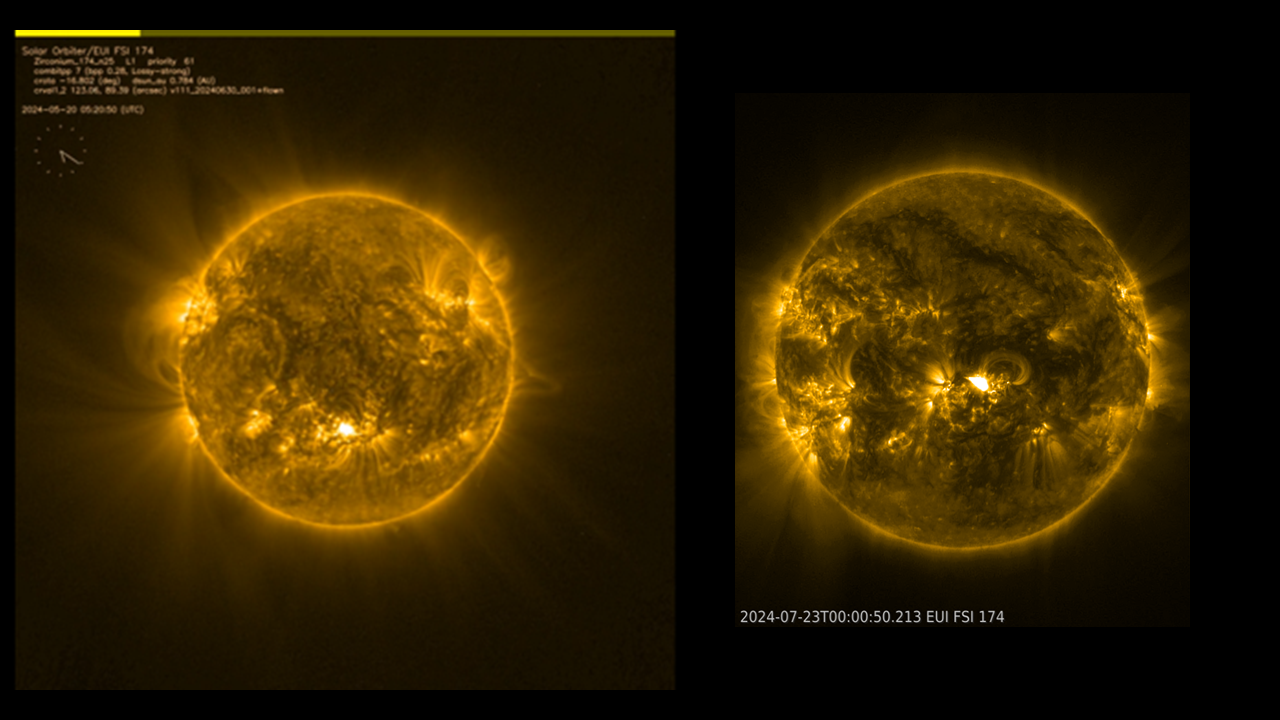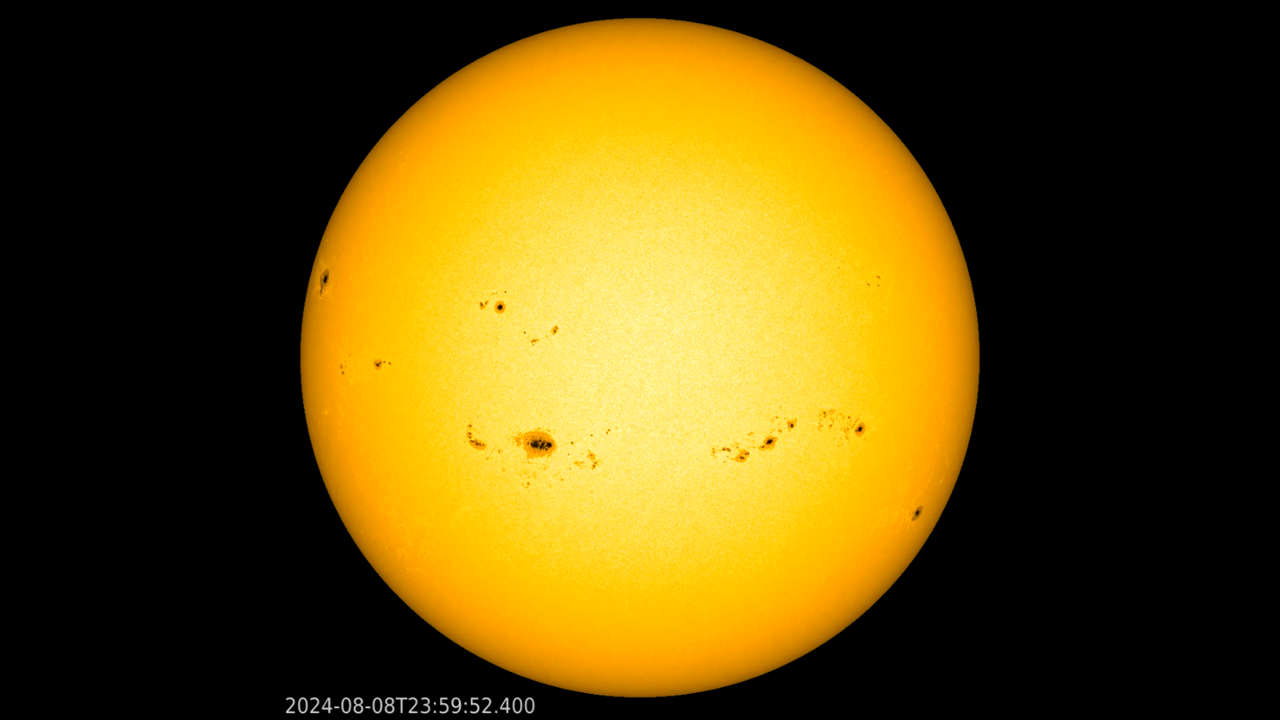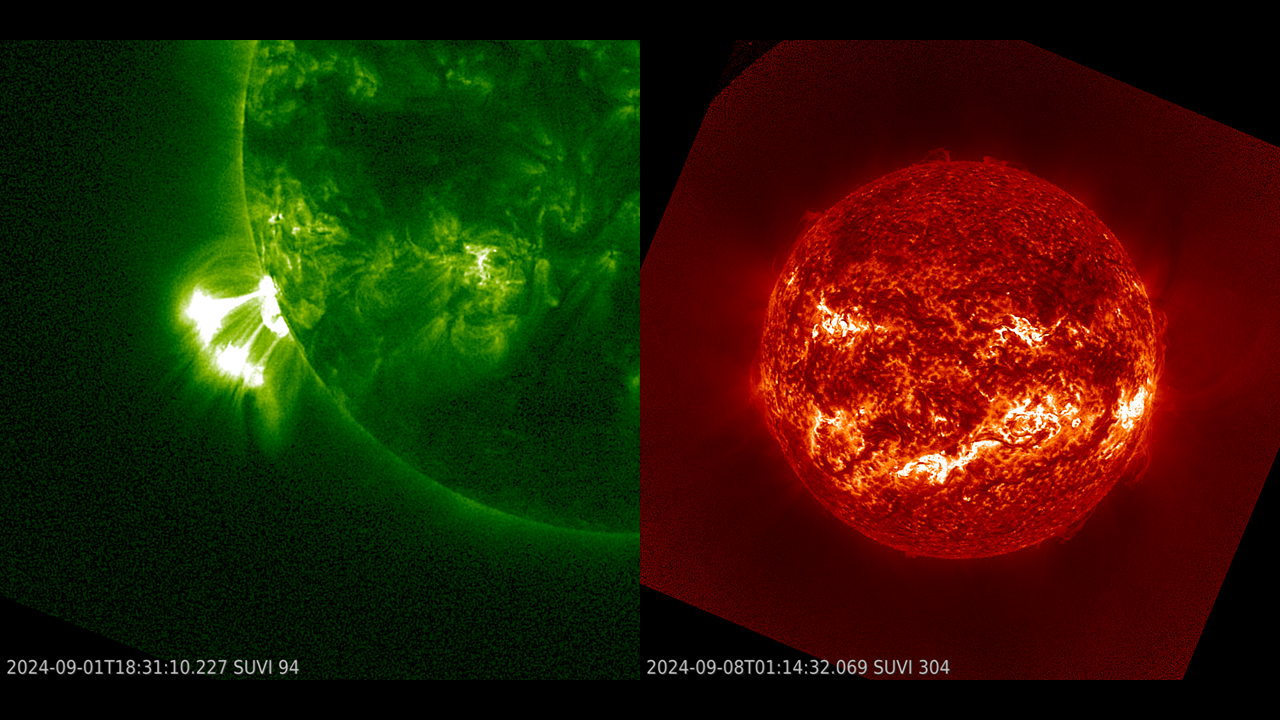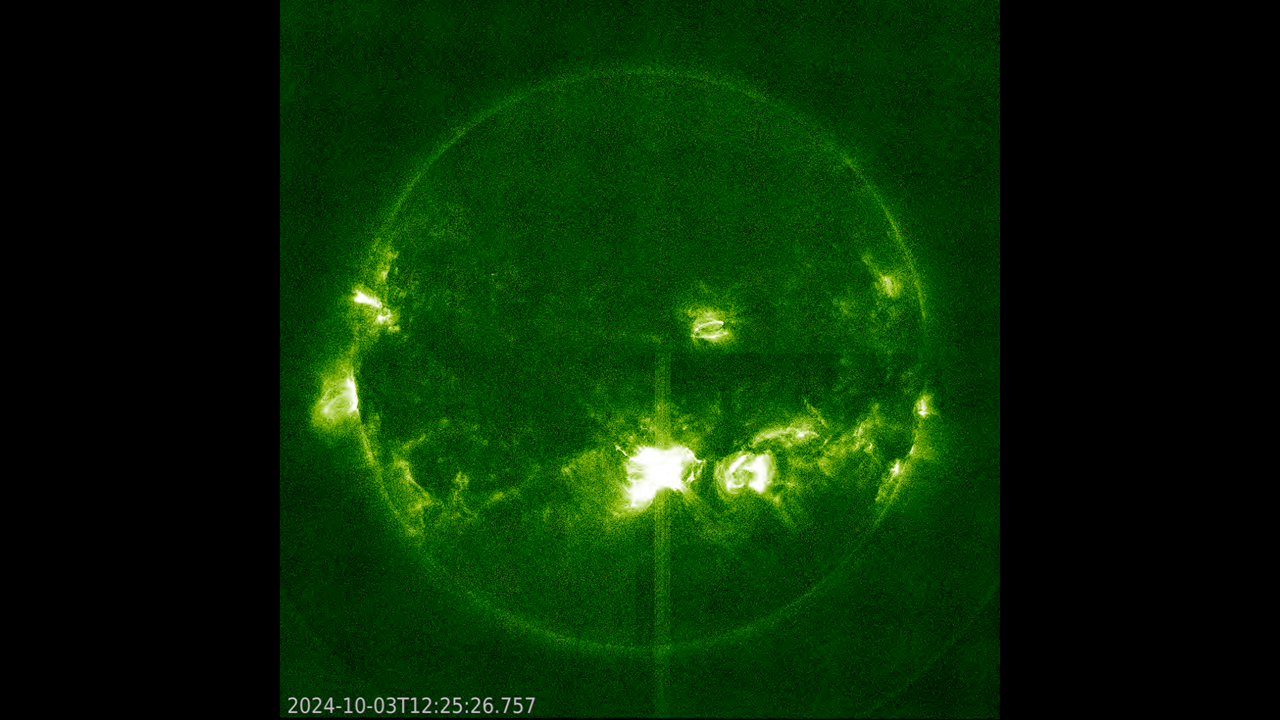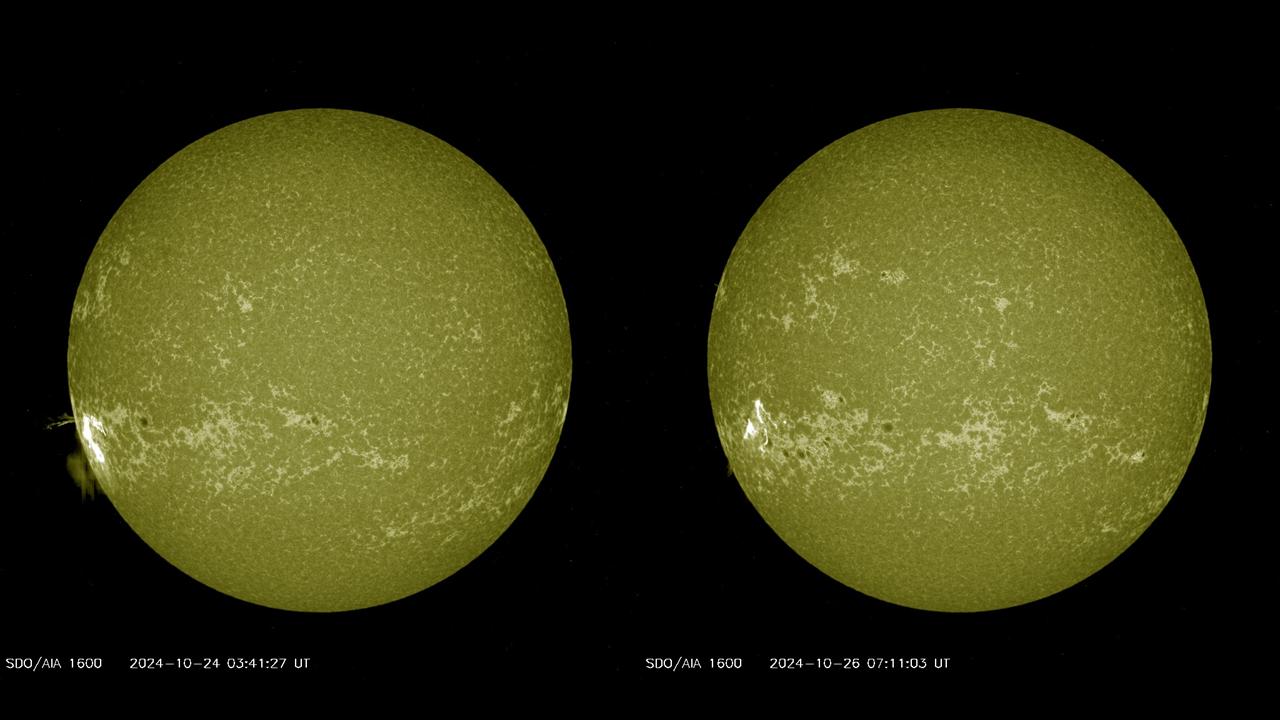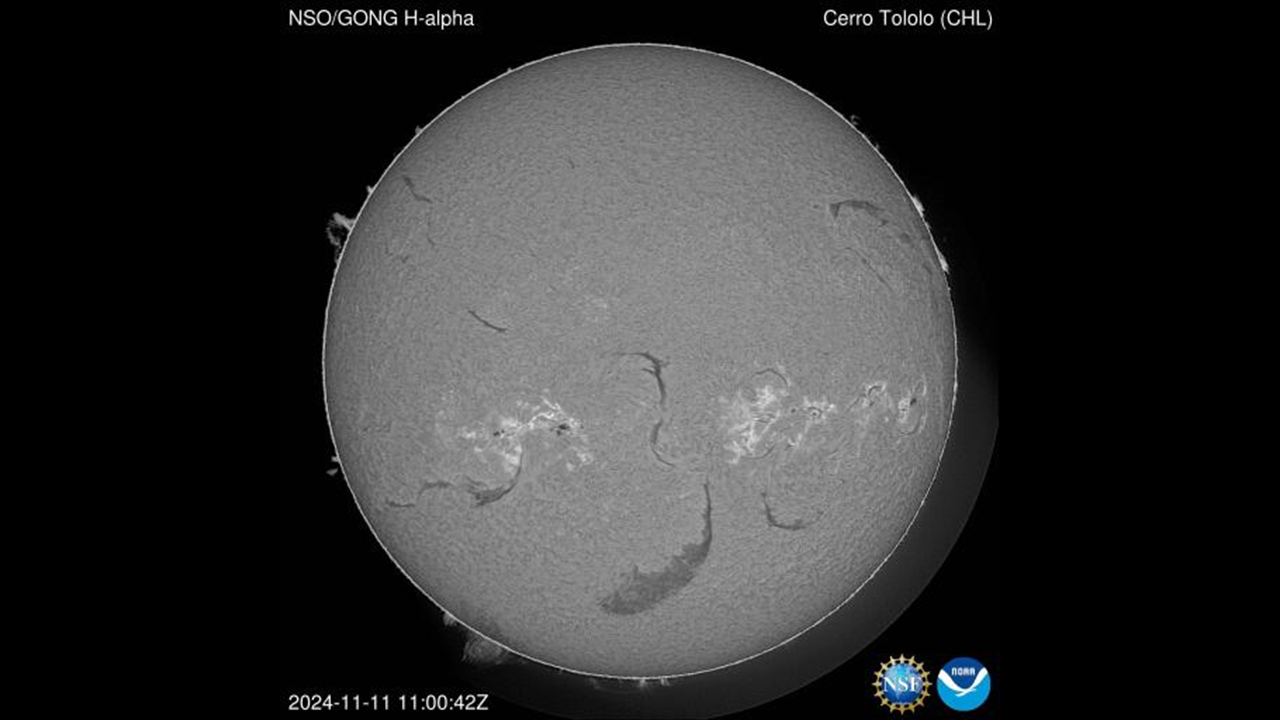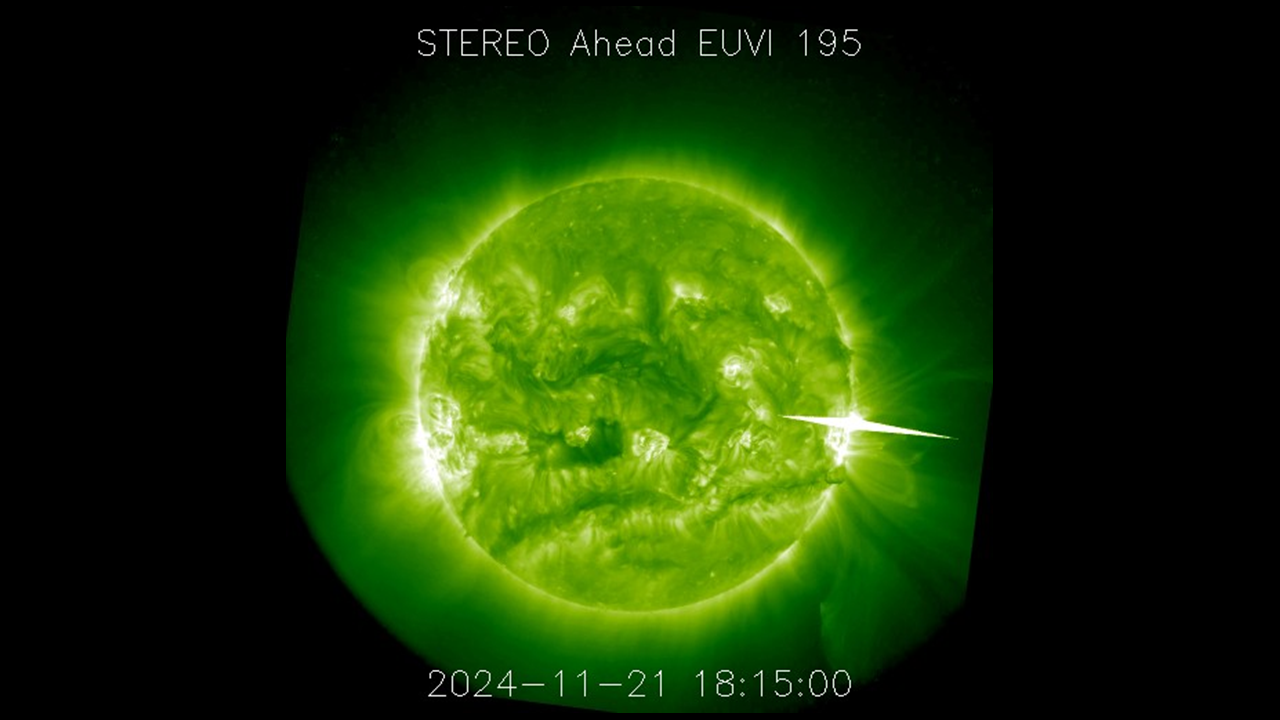A compilation of the most memorable space weather moments of 2023 can be found underneath. Using the versatile Space Weather JHelioviewer (SWHV - https://swhv.oma.be/user_manual/) software, a ***MOVIE*** was created (available on YouTube ) containing one or more clips of each event. Usually, images from SDO, GOES/SUVI, STEREO, and SOHO have been used, occasionally supplemented with imagery from Solar Orbiter, PROBA2/SWAP, ROB/USET and the GONG/H-alpha network.
As this chronological list concerns mostly punctual events on the Sun, it does not contain clips from other noteworthy events in 2024 such as e.g. the total solar eclipses of 8 April and 2 October, and the launch of PROBA-3 on 5 December. Also for a concise overview of space weather events and their impacts so far this solar cycle, please refer to the STCE's SC25 tracking page.
Happy viewing!
Event 1: 9 February - NOAA 3575 produces a strong X3.3 flare
A strong X3.3 flare peaked at 13:14 UTC on 9 February. The source region was thought to be NOAA 13575, located well beyond the southwest limb (about 14 degrees!). Consequently, as the Sun was hiding a portion of the event, the eruption must have been significantly stronger than the intensity in soft x-rays seems to convey. The eruption was associated with a moderately strong proton event.
Ref: STCE newsitems of 9 February and 13 February
Event 2: 9-19 February - Farside transit of NOAA 3575
Solar activity remained high, with numerous coronal mass ejections (CMEs) recorded, mainly from the Sun's farside. A majority of these farside eruptions are thought to originate from NOAA 3575. This complex region rotated over the southwest limb on 8 February, and was the source of an X3 flare a day later. This region was located at a high latitude of -37°, which may explain the asymmetry of the observed halo CMEs. Starting with the CME related to the X3 flare on 9 February, further eruptions linked to NOAA 3575 were those on 12, 14, 15, 17 and 18 February.
Ref: STCE newsitem of 19 February
Event 3: 12-13 February - A duo of eruptions
A duo of eye-pleasing eruptions took place on 12 February and was not related to NOAA 3575 activity. The event consisted of a prominence eruption near the northeast limb around noon on 12 February, followed by another eruption in a region a bit beyond the solar limb around 21:00 UTC on the same day. Features such as post-eruption coronal loops and supra-arcade downflows ("SADs") could be seen. The CMEs had a plane-of-the-sky speed of resp. near 600 km/s and 1200 km/s, and no earth-directed component. The "noise" (white dots) in the coronagraphic images is due to energetic particles crashing onto the camera pixels. It is thought that these particles have their source in the strong farside event from NOAA 3575 earlier that day, generating a moderate solar radiation storm.
Ref: STCE newsitem of 19 February
Event 4: 16 February - Impressive X-class flare eruption
NOAA 3576 was the source of an X2.5 flare on 16 February. Images in extreme ultraviolet showed an impressive eruption with mass being ejected to the southwest. The eruption stretched all the way outside SUVI's (wide!) field of view, and as such towered at least 900.000 km above the Sun's surface i.e. at least 2.5 times the Earth-Moon distance. Several magnetic observatories on the sunlit side of the Earth such as in India (Hyderabad) and Australia (Learmonth) reported a solar flare effect (SFE), with one or more components of the magnetic field strength showing a spike (" magnetic crochet") up to 23 nT. For comparison, the Carrington flare showed an SFE of 110 nT. SFEs may affect high-precision technologies that depend on stable magnetic fields, such as wellbore drilling.
Ref: STCE newsitem of 16 February
Event 5: 23 March - Simultaneous solar eruptions
Early on 23 March, a long duration X1 flare in NOAA 3614 coincided with another long duration, but less intense flare on the southern solar hemisphere in NOAA 3615. The latter was one of the most flare-active sunspot groups of 2024, with 45 M- and 1 X-class flares. The high-speed CME associated with the X1 event arrived already a day later and resulted in a severe geomagnetic storm (Kp = 8+) which was -Kp wise- the strongest storm after the 10-11 May and 10-11 October geomagnetic storms. The powerful interplanetary CME proved to be an effective shield against the cosmic rays, and the neutron monitors recorded a brief but potent 15% decrease in the number of neutrons (a so-called "Forbish decrease").
Ref: STCE newsitems of 23-24 March and of 28 March
Event 6: 17-21 April - Jetlike eruptions from NOAA 3638
Active region NOAA 3638 was a rather small and deceivingly simple member of a sunspot complex that transited the solar disk in April. The region was the source of numerous jetlike eruptions which were associated with relatively narrow CMEs. These CME puffs were mostly directed south of the ecliptic (the plane created by the Earth in its yearly orbit around the Sun).
Ref: STCE newsitem of 23 April
Event 7: 6-15 May - Mighty NOAA 3664 ; Polar lights over Europe
During its transit over the solar disk, NOAA 3664 sized up to become the largest sunspot group of the current solar cycle so far, with an area of about 14 times the total surface area of the Earth. Due to its very complex magnetic structure, NOAA 3664 became one of the most flare-productive active regions since the start of the GOES measurements in 1976. With 53 M- ("medium") and 12 X-class ("extreme") flares, this group now occupies the 4th spot after the legendary NOAA 5395 (March 1989 - 66 M- and 14 X-class flares) and 2 groups from solar cycle 21 (SC21). These flares were associated with a series of earth-directed CMEs that triggered an extremely severe geomagnetic storm on 10 and 11 May. Solar wind speeds reached values around 940 km/s, and Bz reached -50 nT. These were the most extreme solar wind values measured so far this solar cycle. Based on the Disturbance storm time index (Dst), the 10-11 May storm reached -406 nT and is thus the 7th strongest storm since the measurements started in 1957 (WDC Kyoto). We have to go back to October-November 2003 and November 2004 to find storms of comparable strength. On 10-11 May, polar lights were visible all over Europe. Other space weather impacts were limited to disturbances in HF Com (3-30 MHz) for aviation and GNSS problems (agriculture / precise farming, some aviation applications). Power grid networks had taken their precautions and were all in all doing well. Starlink and other satellite systems suffered from the increased atmospheric drag, but eventually survived the extreme conditions.
Ref: STCE newsitems of 8-15 May, 10-14 May, and 21 May ; STCE's SC25 Tracking page
Event 8: 27 May-10 June - Return of the King
NOAA 3697, the return of NOAA 3664, continued the production of strong flares with several spectacular X-class events. This active region was also the source of a weak Ground Level Enhancement on 8 June, which teamed up with the first strong proton event of SC25 (10 MeV proton flux larger than 1000 pfu). NOAA 3664 had already produced a GLE on 11 May.
Ref: STCE newsitems of 27 May-10 June
Event 9: 20 May and 22 July - Powerful farside eruptions
The most powerful flares recorded by GOES so far this solar cycle were the X9.0 flare from NOAA 3842 on 3 October 2024 and the X8.7 from NOAA 3664 on 14 May 2024. However, there's a good chance that the truly most powerful flares took place on the Sun's farside. By virtue of the STIX instrument on board of Solar Orbiter, the eruptions on 20 May and 22 July could be proxied to have an intensity of resp. X12 and X14, with a rather wide uncertainty margin. The 20 May eruption was produced by NOAA 3664 during its farside transit, and was associated with a spectacular coronal dimming. The 22 July flare was associated with a minor proton event observed by GOES.
Ref: STCE newsitem of 2 July and 23 July
Event 10: July-August - High sunspot numbers
Sunspot numbers reached very high values in July and August, with the respective monthly sunspot numbers at 196.8 and 216.0 (SILSO). During 3 periods (16-19 July, 31 July-1 August, 7-10 August), the daily sunspot number reached 250 or more. The highest daily sunspot number of the year was recorded on 18 July (290). The July period was mainly driven by a multitude of small sunspot groups, whereas in August the sunspot groups were a bit less numerous but much larger. On a few days in August, there were -at the same time- 3 sunspot groups visible to the naked eye (using eclipse glasses). Solar activity was dominated by the southern solar hemisphere in 2024. The numerous eruptions resulted in some earth-directed CMEs, with a strong geomagnetic storm taking place on 12 August. This was -Dst wise- the strongest storm of 2024 after the May and October storms.
Ref: STCE newsitems of 22 July, 6 August, and 24 September
Event 11: First half of September - Stunning eruptions
The first half of September was marked by some stunning eruptions. Several active regions such as NOAA 3811 and NOAA 3825, as well as some unstable filaments contributed to the high solar activity with multiple M-class flares and even a few X-class events. This activity drove the x-ray background flux above the M1-level from 12 September around 21:30UTC until 13 September around 09:30UTC, meaning that the GOES could only detect M-class or stronger flares for nearly half a day.
Ref: STCE newsitems of 14 September and 17 September
Event 12: 3 October - Strongest X-class flare of SC25 so far...
NOAA 3842 was the source of several X-class flares early October, including an X9.0 on 3 October that still is the strongest solar flare so far this solar cycle, and the strongest since September 2017. The CMEs associated with the continued flaring by NOAA 3842 would eventually result in a strong geomagnetic storm on 7-8 October, with the local K index for Belgium (K_BEL) stuck at a modest minor storm level.
Ref: STCE newsitems of 2-9 October and 21 October
Event 13: 9 and 10-11 October - X1 flare by NOAA 3848 ; Polar lights over Europe again...
Early on 9 October, NOAA 3848 unleashed a long-duration X1 flare. Coronagraphic imagery showed that the associated CME was directed straight to Earth, and were adorned by the comet Tsuchinshan–ATLAS which was flying through SOHO/LASCO's field of view. The greater than 10 MeV proton flux started to increase and reached a maximum value of 1810 pfu, coinciding with the passage of the interplanetary CME. This makes it the strongest proton event so far this solar cycle (SC25). High Frequencies (HF; 3-30 MHz) over the poles were affected, a so-called Polar Cap Absorption (PCA). The CME arrived around 15:00 UTC on 10 October, and triggered a severe geomagnetic storm (almost extreme: Kp = 9-), so slightly less intense than the May storm. Aurora were observed and/or photographed as far south as California and Texas in the United States, and from Italy and Greece in Europe, as well as South-Africa and Australia (Spaceweather.com). GNSS was again not available over North-America (WAAS), for no less than 16 hours! HF Com, already affected during the preceding X-class flares, was again impacted, in particular during the days after the storm when the upper portion of the high frequencies (HF; 3-30 MHz) was depressed at some locations and for certain intervals. The increased atmospheric drag seems to have advanced the re-entry from a Starlink satellite at very low earth orbit by 10 days. ESA moved some satellites up in their orbits, to avoid premature re-entry.
Ref: STCE newsitems of 9-11 October ; STCE's SC25 Tracking page
Event 14: 24 and 26 October - Fast CMEs, puny geomagnetic disturbances
On 24 October, NOAA 3869 produced an X3.3 flare. Two days later, NOAA 3873 produced an X1.8 flare. Both sunspot regions were part of a string of sunspot groups visible in the southeast solar quadrant. Both eruptions were associated with an asymmetric halo CME, due to the close proximity of the source regions near the southeast solar limb. The CMEs had a speed of resp. about 1300 km/s and 1600 km/s. In both cases, the bulk of the CME was directed away from Earth, but both delivered a glancing blow to the earth environment. Travel time for these interplanetary CMEs was resp. about 59 hours and 45 hours. The resulting geomagnetic disturbance from these ICMEs was all-in-all mild, as could be expected from a glancing blow. The global Kp index reached resp. active and minor storming conditions.
Ref: STCE newsitems of 24-26 October, 26 October, and 29 October
Event 15: 11 November - Stunning filament eruption
On 11 November, an impressive filament erupted from the Sun's southern hemisphere. In H-alpha, the filament had a length of nearly 500.000 km, significantly longer than the typical Earth-Moon distance. The eruption lasted for several hours, and was accompanied by another filament/prominence eruption near the southeast solar limb around the same time. Extreme ultraviolet (EUV) images suggest that the prominence at the limb was connected with the big filament by a filament channel. As a result, there was only a single coronal mass ejection (CME) associated with this eruption, that was not earth-directed.
Ref: STCE newsitem of 18 November
Event 16: 25 November - Proton event and GLE... from the farside!
Out of the blue, a moderate proton event started on 21 November. Also the greater than 100 MeV proton flux increased, and a weak GLE was recorded - the third of 2024 and already the forth of the ongoing solar cycle. In view of the response from the high energy protons, one would assume a strong flaring event to have taken place. However, the GOES did not record a significant flare around that time. SOHO coronagraphic imagery showed a potent CME in the northwestern direction. According to CACTus (SIDC), this partial halo CME was fast with a plane-of-the-sky speed around 1100 km/s, and not earth-directed. The intensity and location of the flare was determined from STEREO-A observations. The source of the estimated X4.3 flare was most likely NOAA 3889, located at least 28 degrees beyond the Sun's west limb as seen from Earth. This region was an active M-class flare producer (22!) during its transit over the solar disk. Some interaction with nearby NOAA 3897 is not excluded. At any rate, this must have been quite a complex eruption, taking place at the west-southwest limb but ejecting the CME in the northwestern direction.
Ref: STCE newsitem of 25 November

